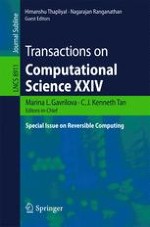The LNCS journal Transactions on Computational Science reflects recent developments in the field of Computational Science, conceiving the field not as a mere ancillary science but rather as an innovative approach supporting many other scientific disciplines. The journal focuses on original high-quality research in the realm of computational science in parallel and distributed environments, encompassing the facilitating theoretical foundations and the applications of large-scale computations and massive data processing. It addresses researchers and practitioners in areas ranging from aerospace to biochemistry, from electronics to geosciences, from mathematics to software architecture, presenting verifiable computational methods, findings, and solutions and enabling industrial users to apply techniques of leading-edge, large-scale, high performance computational methods. This, the 24th issue of the Transactions on Computational Science journal, guest edited by Himanshu Thapliyal and Nagarajan Ranganathan, is devoted to the topic of reversible computing. It is comprised of eight selected papers on reversible energy recovery designs, design of reversible logic gates and arithmetic circuits in optical computing, reversible basic linear algebra subprograms, quantum circuit description language, and reversible circuit and logic synthesis.
